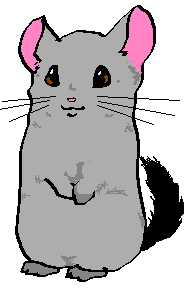
Introduction

What exactly is a Chinchilla?
Chinchillas are moderate sized members of the rodent family, slightly larger
than a guinea pig. They have been extensively raised for the fur industry,
thanks to their extremely soft fur coats. The most common color variation
is grey/silver, but there are a variety of color mutations from white to black.
They live about 15 years, although pets up to 25 or older have been reported.
Chinchilla
belongs to the family of rodent. A chinchilla has been defined as a furry animal
with wiry tail. What make them extremely loveable are their big eyes,
round ears, thick and silky fur, and not forgetting their persistent and undying
curiosity. These qualities make them really cute and charming.
However, because of their beautiful fur, chinchillas are also being breed by the
fur industry. Sadly, one will need over a hundred chinchillas to make a
fur coat for one person.
They have a length of about 10 inches that is not including the tail. The weight
is about 1-2 pounds. It has soft, dense fur usually silver gray and has large
eyes, long whiskers and bushy tail. It also has a large hind feet and small
front legs where the females are larger than males. You may be wondering why
their coat is so dense, as they have numerous fine hairs grow from each single
hair follicle.
They are herbivorous, crepuscular. They lives in social groups ranging from 14
– 100 animals. They preyed upon by small mammals, snakes and birds of prey.
There are different types of Chinchillas, namely Lanigera, Costina and
Brevicaulda. Most chinchillas come from Lanigera. The other types come
about due to the effort of breeders and natural mutations. Some said that
Costina and Brevicaulda are Lanigera that adapted to different altitudes.
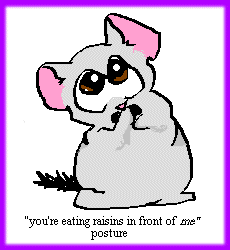
Lanigera:
It has straight, blunt nose
with medium size ears and long tail.
Brevicaulda:
It is larger and more chunky
than Lanigera. It has blunt nose with short round ears and tail.
Costina:
This is smaller and slimmer
than Lanigera. It has a narrow and rat-like nose with bigger ears and longer
tail.
There
is THREE kinds of rodents based on our skull structure:
i.
SCIUROMORPHS
ii.
MYOMORPHS
iii.
HYSTRICOMORPHS
Let
us concentrate on the HYSTRICOMORPHS first, now one of the HYSTRICOMORPHS family
is called the CHINCHILLIDAE. Is it beginning to sound familiar now?
Well, it doesn't stop there, we now have to break this family
CHINCHILLIDAE down further. Believe it or not the CHINCHILLIDAE family is broken
down into SIX species which are:
·
FOUR are 'VISCACHA'
·
TWO are
'CHINCHILLA'
Here is a picture of one of the 'viscacha' family - known as the 'plains viscacha'
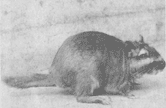 This
is the LAGOSTOMU MAXIMUS ( try saying that with a mouthful of raisins )
This
is the LAGOSTOMU MAXIMUS ( try saying that with a mouthful of raisins )
They
live on the plains of the Argentine pampas, have coarse gray hair and black and
white stripes across a blunt rat like face
Now
lets forget about the ugly viscacha family and lets go into a little more detail
about the cuter ones - the CHINCHILLA!
There
is two types of chinchilla:
·
LANIGERA
·
BREVICAUDATA
(or BOLIVIANA)
The
chinchilla 'brevicaudata' is the 'short-tailed' one, see this drawing below
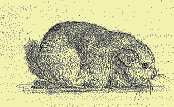
Looks
more like a guinea pig with a short bushy tail - this one is practically
extinct!
Well,
let's face it - why buy an expensive one of these when guinea pigs come cheap!
The
other is CHINCHILLA LANIGERA
That's
us! and here is a picture of a real wild one - bet you haven't got one of these!
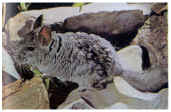
Both
the lanigera and the brevicaudata chinchillas were brought into the USA for
breeding, but the brevicaudata didn't do very well as the lanigera guys so the
breeders kicked them out and concentrated on the lanigera chinnie